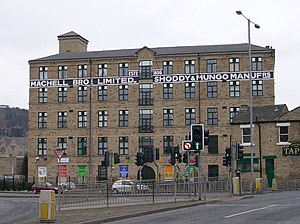
The Heavy Woollen District is a region of textile-focused industrial development in West Yorkshire, England. It acquired the name because of the heavyweight cloth manufactured there from the early 19th century.[1][unreliable source?][2]
The district is made up of parts of the modern day boroughs of Kirklees, Leeds and Wakefield in West Yorkshire, England.[3] Located around the towns of Dewsbury,[4] Batley,[5] Heckmondwike and Ossett,[6] the area extends to the towns and villages of Liversedge, Gomersal, Gildersome, Birkenshaw, Mirfield, Cleckheaton, Morley, Tingley, East Ardsley, Birstall and Horbury. The manufacture of wool cloth for clothing, blankets, rope and twine continues in the district.
The area was one of the key textile centres in Yorkshire, famed for its production of shoddy and mungo.[7][page needed][8] For years companies had tried to blend different fibres without success leading to the term, "munt go", i.e. "mustn't go" as a Yorkshire colloquialism. Machinery invented in Batley to grind soft rags (shoddy) is thought to have first been devised in 1813,[9] and for hard rags (mungo) later on. Most mills have either closed or put to other uses, but some shoddy/mungo mills remain such as Edward Clay & Son Ltd. in Ossett.

- ^ "Heavy Woollen District". The Dewsbury Partnership. Retrieved 28 March 2021.
- ^ "Wealth of war for boom mills". Dewsbury Reporter. 3 January 2008. Archived from the original on 1 July 2016. Archived from the original on 1 July 2016. Retrieved 4 April 2021
- ^ Nostalgia on Tuesday: Rise of the tram The Yorkshire Post, 13 June 2017. "...to feed the heavy woollen districts of Thornhill, Ravensthorpe, Heckmondwike, Batley, Liversedge, Hightown, Moorend and Birkenshaw." Retrieved 29 March 2021
- ^ "About Us Page". henryday.co.uk. Henry Day & sons, Dewsbury. Retrieved 6 April 2021.
- ^ Chisholm, Hugh, ed. (1911). . Encyclopædia Britannica. Vol. 8 (11th ed.). Cambridge University Press. p. 521.
- ^ Tattersfield 1909, p. 414.
- ^ Shell 2020.
- ^ Chisholm, Hugh, ed. (1911). . Encyclopædia Britannica. Vol. 8 (11th ed.). Cambridge University Press. p. 1054.
- ^ Shell 2020, pp. 26–27.
© MMXXIII Rich X Search. We shall prevail. All rights reserved. Rich X Search
